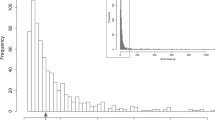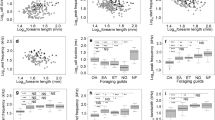Abstract
Chiroptera is the only group of mammals capable of powered flight. The mechanical basis of bat flight is well established, but evolution of its constituent aerodynamic variables remains poorly understood. Here, we determine the macroevolutionary patterns of traditional aerodynamic variables (wing loading, aspect ratio, tip shape index) in a comprehensive phylogeny of Chiroptera using an extensive dataset including key Eocene fossils. We optimized variables as continuous characters and fit models of character evolution to identify shifts in character optima. The reconstructed ancestral chiropteran morphotype presented low wing loading and low-to-intermediate aspect ratio, and remained unaltered for much of the first half of bat evolution (Paleogene). This evolutionary pattern may be explained by stabilizing selection responding to the strong constraints imposed by echolocation and flight on body size, and the physical constraints regarding aerodynamic efficiency acting on wing shape. Posterior specialization in some groups permitted divergence toward novel aerodynamic morphotypes in the second half of chiropteran evolutionary history (Neogene). We linked the most notable aerodynamic changes to ecological release from echolocation constraints (Pteropodidae), dietary-foraging shifts (Phyllostomidae, Noctilionidae), or advantage in face of environmental changes (Molossidae, Taphozoinae). The independently-evolved specialization of fast, enduring flight that allowed Molossidae and Taphozoinae (Emballonuridae) to perform aerial hawking of swarming insects in open spaces was linked to significant shifts in the optima of both wing loading and aspect ratio. These shifts were probably associated with the gradual spread of open-mosaic landscapes at a global scale since the Oligocene.






Similar content being viewed by others
Data Availability
All data generated or analyzed during this study are included in this published article and its supplementary information files (see ESM_1).
References
Abello MA, Toledo N, Ortiz-Jaureguizar E (2018) Evolution of South American Paucituberculata (Metatheria: Marsupialia): adaptive radiation and climate changes at the Eocene-Oligocene boundary. Hist Biol. https://doi.org/10.1080/08912963.2018.1502286
Aldridge HDJN, Rautenbach IL (1987) Morphology, echolocation and resource partitioning in insectivorous bats. J Anim Ecol 56:763–778
Amador LI, Arévalo-Moyers RL, Almeida FC, Catalano SA, Giannini NP (2018) Bat systematics in the light of unconstrained analyses of a comprehensive molecular supermatrix. J Mammal Evol 25:37–70
Amador LI, Giannini NP (2016) Phylogeny and evolution of body mass in didelphid marsupials (Marsupialia: Didelphimorphia: Didelphidae). Org Divers Evol 16:641–657
Amador LI, Simmons NB, Giannini NP (2019) Aerodynamic reconstruction of the primitive fossil bat Onychonycteris finneyi (Mammalia: Chiroptera). Biol Lett 15:20180857
Bahlman JW, Price-Waldman, RM, Lippe HW, Breuer KS, Swartz SM (2016) Simplifying a wing: diversity and functional consequences of digital joint reduction in bat wings. J Anat 229:114–127
Bouchenak-Khelladi Y, Muasya AM, Linder HP (2014) A revised evolutionary history of Poales: origins and diversification. Bot J Linnean Soc 175:4–16
Bullen R, McKenzie NL (2001) Bat airframe design: flight performance, stability and control in relation to foraging ecology. Aust J Zool 49:235–261
Cooper N, Thomas GH, Venditti C, Meade A, Freckleton RP (2016) A cautionary note on the use of Ornstein-Uhlenbeck models in macroevolutionary studies. Biol J Linnean Soc 118:64–77
Dumont ER (2007) Feeding mechanisms in bats: variation within the constraints of flight. Integr Comp Biol 47:137–146
Elangovan V, Raghuram H, Satya Priya EY, Marimuthu G (2004) Wing morphology and flight performance in Rousettus leschenaulti. J Mammal 85:806–812
Freeman PW (1998) Form, function, and evolution in skulls and teeth of bats. In: Kunz TH, Racey PA (eds) Bat Biology and Conservation. Smithsonian Institution Press, Washington and London, pp 140–156
Giannini NP (2012) Toward an integrative theory on the origin of bat flight. In: Gunnell GF, Simmons NB (eds) Evolutionary History of Bats. Cambridge University Press, Cambridge, pp 355–384
Giannini NP, Kalko EK (2005) The guild structure of animalivorous leaf-nosed bats of Barro Colorado Island, Panama, revisited. Acta Chiropterol 7:131–146
Goloboff PA, Farris JS, Nixon KC (2008) TNT, a free program for phylogenetic analysis. Cladistics 24:774–786
Goloboff PA, Mattoni CI, Quinteros AS (2006) Continuous characters analyzed as such. Cladistics 22:589–601
Harmon LJ, Weir JT, Brock CD, Glor RE, Challenger W (2007) GEIGER: investigating evolutionary radiations. Bioinformatics 24:129–131
Hayssen V, Kunz TH (1996) Allometry of litter mass in bats: maternal size, wing morphology, and phylogeny. J Mammal 77:476–490
Hedenström A, Johansson LC (2015) Bat flight: aerodynamics, kinematics and flight morphology. J Exp Biol 218:653–663
Hedenström A, Johansson LC, Wolf M, von Busse R, Winter Y, Spedding GR (2007) Bat flight generates complex aerodynamic tracks. Science 316:894–897
Hodgkison R, Balding ST, Zubaid A, Kunz TH (2004) Habitat structure, wing morphology, and the vertical stratification of Malaysian fruit bats (Megachiroptera: Pteropodidae). J Trop Ecol 20:667–673
Jones G (1999) Scaling of echolocation call parameters in bats. J Exp Biol 202:3359–3367
Kay R (this volume) Leonard B. Radinsky (1937–1985), radical biologist. J Mammal Evol
Lawlor TE (1973) Aerodynamic characteristics of some Neotropical bats. J Mammal 54:71–78
Maltby A, Jones KE, Jones G (2010) Understanding the evolutionary origin and diversification of bat echolocation calls. In: Brudzinsky (Ed) Handbook of Mammalian Vocalization. Elsevier, London, pp 37–47
McGowan C (1999) A Practical Guide to Vertebrate Mechanics. Cambridge University Press, Cambridge, 301 pp
McGowan AJ, Dyke GJ (2007) A morphospace-based test for competitive exclusion among flying vertebrates: did birds, bats and pterosaurs get in each other's space? J Evol Biol 20:1230–1236
McKenzie NL, Gunnell AC, Yani M, Williams MR (1995) Correspondence between flight morphology and foraging ecology in some palaeotropical bats. Aust J Zool 43:241–257
Moyers-Arévalo RL, Amador LI, Almeida FC, Giannini NP (2018) Evolution of body mass in bats: insights from a large supermatrix phylogeny. J Mammal Evol. https://doi.org/10.1007/s10914-018-9447-8
Muijres FT, Henningsson P, Stuiver M, Hedenström A (2012a) Aerodynamic flight performance in flap-gliding birds and bats. J Theor Biol 306:120–128
Muijres FT, Johansson LC, Barfield R, Wolf M, Spedding GR, Hedenström A (2008) Leading-edge vortex improves lift in slow-flying bats. Science 319:1250–1253
Muijres FT, Johansson LC, Bowlin MS, Winter Y, Hedenström A (2012b) Comparing aerodynamic efficiency in birds and bats suggests better flight performance in birds. PLoS One. https://doi.org/10.1371/journal.pone.0037335
Neuweiler G (1989) Foraging ecology and audition in echolocating bats. Trends Ecol Evol 4:160–166
Neuweiler G (2000) The Biology of Bats. Oxford University Press, New York, 266 pp
Norberg UM (1972) Functional osteology and myology of the wing of the dog-faced bat Rousettus aegyptiacus (E. Geoffroy)(Mammalia, Chiroptera). Z Morphol Tiere 73:1–44
Norberg UM (1981) Allometry of bat wings and legs and comparison with birds wings. Philos Trans R Soc Lond B 292:359–398
Norberg UM (1986) Evolutionary convergence in foraging niche and flight morphology in insectivorous aerial-hawking birds and bats. Ornis Scand 17:253–260
Norberg UM (1990) Vertebrate Flight: Mechanics, Physiology, Morphology, Ecology and Evolution. Springer-Verlag, Berlin, 291 pp
Norberg UM (1994) Wing design, flight performance, and habitat use in bats. In: Wainwright PC, Reilly SM (eds) Ecological Morphology: Integrative Organismal Biology. University of Chicago Press, Chicago, pp 205–239
Norberg UM, Brooke AP, Trewhella WJ (2000) Soaring and non-soaring bats of the family Pteropodidae (flying foxes, Pteropus spp.): wing morphology and flight performance. J Exp Biol 203:651–664
Norberg UM, Fenton MB (1988) Carnivorous bats? Biol J Linnean Soc 33:383–394
Norberg UML, Norberg RÅ (2012) Scaling of wingbeat frequency with body mass in bats and limits to maximum bat size. J Exp Biol 215:711–722
Norberg UM, Rayner JM (1987) Ecological morphology and flight in bats (Mammalia: Chiroptera): wing adaptations, flight performance, foraging strategy and echolocation. Philos Trans R Soc Lond B 316:335–427
Pennycuick CJ (1989) Bird Flight Performance. Oxford University Press, Oxford
Radinsky LB (1987) The Evolution of Vertebrate Design. University of Chicago Press, Chicago, 187 pp
Rayner JMV (1986) Vertebrate flapping flight mechanisms and aerodynamics, and the evolution of flight in bats. In: Natctigall W (Ed) Biona report no. 5: Bat flight. Gustav Fisher, Stuttgart, pp 27–74
R Core Team (2018) R: A Language and Environment for Statistical Computing. R Foundation for Statistical Computing, Vienna. https://www.R-project.org
Revell LJ (2012) Phytools: an R package for phylogenetic comparative biology (and other things). Methods Ecol Evol 3:217–223
Rossoni DM, Assis APA, Giannini NP, Marroig G (2017) Intense natural selection preceded the invasion of new adaptive zones during the radiation of New World leaf-nosed bats. Sci Rep. https://doi.org/10.1038/s41598-017-08989-6
Santana SE, Strait S, Dumont ER (2011) The better to eat you with: functional correlates of tooth structure in bats. Funct Ecol 25:839–847
Schober W, Grimmberger E (1997) The Bats of Europe and North America; Knowing Them, Identifying Them, Protecting Them. TFH Publications, Neptune, NJ
Sears KE, Behringer RR, Rasweiler JJ, Niswander LA (2006) Development of bat flight: morphologic and molecular evolution of bat wing digits. Proc Natl Acad Sci USA 103:6581–6586
Simmons NB, Cirranello AL (2018) Bat Species of the World: A Taxonomic and Geographic Database (http://batnames.org Accessed on 01/29/2019)
Simmons NB, Seymour KL, Habersetzer J, Gunnell GF (2008) Primitive early Eocene bat from Wyoming and the evolution of flight and echolocation. Nature 451:818–823
Simmons NB, Seymour KL, Habersetzer J, Gunnell GF (2010) Inferring echolocation in ancient bats. Nature 466:939–942. https://doi.org/10.1038/nature09219
Smith T, Habersetzer J, Simmons NB, Gunnell GF (2012) Systematics and paleobiogeography of early bats. In: Gunnell GF, Simmons NB (eds) Evolutionary History of Bats. Cambridge University Press, Cambridge, pp 23–66
Song A, Tian X, Israeli E, Galvao R, Bishop K, Swartz S, Breuer K (2008) Aeromechanics of membrane wings with implications for animal flight. AIAA J 46:2096–2106
Stern AA, Kunz TH, Bhatt SS (1997) Seasonal wing loading and the ontogeny of flight in Phyllostomus hastatus (Chiroptera: Phyllostomidae). J Mammal 78:1199–1209
Strömberg CA (2011) Evolution of grasses and grassland ecosystems. Annu Rev Earth Planet Sci 39:517–544
Swartz SM, Freeman PW, Stockwell EF (2003) Ecomorphology of bats: comparative and experimental approaches relating structural design to ecology. In: Kunz TH, Fenton MB (eds) Bat Ecology. University of Chicago Press, Chicago, pp 257–300
Swartz SM, Groves MS, Kim HD, Walsh WR (1996) Mechanical properties of bat wing membrane skin. J Zool 239:357–378
Tavares VC (2014) Phyllostomid (Chiroptera: Phyllostomidae) bat wings from Atlantic Forest bat ensembles: an ecomorphological study. Chiropt Neotrop 19:57–70
Tian X, Iriarte-Diaz J, Middleton K, Galvao R, Israeli E, Roemer A, Sullivan A, Song A, Swartz S, Breuer K (2006) Direct measurements of the kinematics and dynamics of bat flight. AIAA J. https://doi.org/10.1088/1748-3182/1/4/S02
Uyeda JC, Eastman J, Harmon L (2014) bayou: Bayesian fitting of Ornstein-Uhlenbeck models to phylogenies. R package version 1.1.
Uyeda JC, Harmon LJ (2014) A novel Bayesian method for inferring and interpreting the dynamics of adaptive landscapes from phylogenetic comparative data. Syst Biol 63:902–918
Vaughan TA (1966) Morphology and flight characteristics of molossid bats. J Mammal 47:249–260
Voigt CC, Holderied MW (2012) High maneuvering costs force narrow-winged molossid bats to forage in open space. J Comp Physiol B 182:415–424
Waldman RM, Breuer KS (2017) Camber and aerodynamic performance of compliant membrane wings. J Fluids Struct 68:390–402
Wang L, Lin A, Xiao Y, Jiang T, Feng J (2014) Postnatal development in the big-footed bat, Myotis macrodactylus: wing morphology, echolocation calls, and flight. Acta Theriol 59:435–441
Wang Z, Zhu T, Xue H, Fang N, Zhang J, Zhang L, Pang J, Teeling EC, Zhang S (2017) Prenatal development supports a single origin of laryngeal echolocation in bats. Nature Ecol Evol. https://doi.org/10.1038/s41559-016-0021
Acknowledgments
We thank to G. Cassini, N. Toledo, and S. Vizcaíno for inviting us to participate in this tribute to L.B. Radinsky within the framework of the Symposium: “El paradigma de correlación forma-función en mastozoología: un tributo a Leonard Radinsky (1937–1985)”, which took place during the XXXI Jornadas Argentinas de Mastozoología, in La Rioja, Argentina. 25 October, 2018. We also thank the two anonymous reviewers for their comments that substantially helped to improve the manuscript.
Funding
NPG was funded by PICT 2015–2389 and PICT 2016–3682; LIA by a postdoctoral fellowship (CONICET).
Author information
Authors and Affiliations
Corresponding author
Ethics declarations
Conflict of Interest
The authors declare that they have no conflict of interest.
Comment on Ethics
This article does not contain any studies with human participants or animals performed by any of the authors.
Rights and permissions
About this article
Cite this article
Amador, L.I., Almeida, F.C. & Giannini, N.P. Evolution of Traditional Aerodynamic Variables in Bats (Mammalia: Chiroptera) within a Comprehensive Phylogenetic Framework. J Mammal Evol 27, 549–561 (2020). https://doi.org/10.1007/s10914-019-09475-8
Published:
Issue Date:
DOI: https://doi.org/10.1007/s10914-019-09475-8




